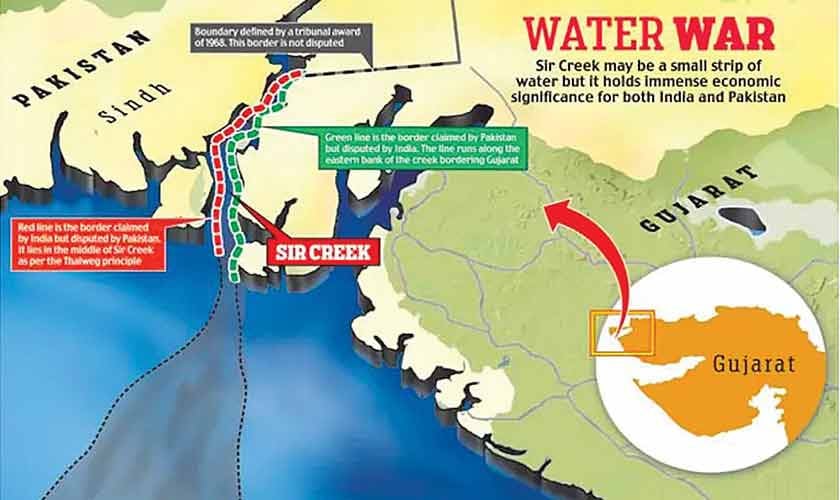Driven by the political exigency of the Bihar elections, India’s leadership has reignited an old fire. Prime Minister Narendra Modi’s invocation of Operation Sindoor and threats to change geographies have been followed by his defence minister’s explicit threat regarding the Sir Creek. This is reckless brinkmanship.
### The Strategic Significance of Sir Creek
The Sir Creek area is a 96-kilometre-long tidal estuary located in the Indus Delta, forming part of the border between Sindh and India’s Gujarat. It is among Pakistan’s most strategically crucial and ecologically sensitive areas. Lying at the edge of the Indus River Delta, vital shipping routes and fishing grounds, it holds significant economic and geopolitical importance.
Its proximity to the international maritime boundary with India makes it a geopolitically sensitive zone. Control of Sir Creek is essential for safeguarding Pakistan’s maritime boundaries and preserving its exclusive economic zone (EEZ), which is abundant in marine resources. The estuary’s ever-shifting tidal surges and sediment deposition render nautical charts unreliable and navigation challenging. To secure the frontier, naval and marine personnel must conduct frequent surveillance and patrols, often in hovercraft and boats, even on foot, through the treacherous terrain.
### Historical and Legal Context
Pakistan claims rights, in accordance with the Bombay Government Resolution of 1914, to the entire waters surrounding and fed by the creek, says Rear Admiral Foad Baig, a former director general of the Pakistan Maritime Security Agency. This agreement, part of the Surveyor General’s Map, fixed the border on the creek’s eastern bank. Pakistan’s position is therefore based on upholding this pre-existing, fixed boundary.
Pakistan has argued that the Thalweg principle—which places the boundary mid-stream—is inapplicable as the creek is a non-navigable estuary and the border was never intended to shift with the channel. Demonstrating its commitment to a peaceful solution, Pakistan prioritised bilateral resolution, which led to a joint survey in 2007 and an exchange of agreed-upon maps. However, this process was halted when, following the Mumbai terrorist attacks, India withdrew in 2008.
Despite India’s position on Sir Creek, Pakistan’s claim to an extended Continental Shelf 150 nautical miles (NM) beyond the EEZ was accepted in March 2015. This granted Pakistan 50,000 square kilometres of seabed territory, giving legal control over natural resources in this offshore area, according to Rear Admiral Baig.
### Strategic Military Developments
The Sir Creek dispute dates back to the April 1965 Rann of Kutch battle. Around 20 years ago, the Pakistan Navy established its Coastal Command. This strategic initiative was designed to enhance amphibious and expeditionary warfare capabilities and ensure naval readiness. The Pakistan Marines, raised about two decades ago, are mandated to defend the creeks area southeast of Karachi.
Pakistan Marines operate in one of the most challenging environments worldwide. Rear Admiral Baig describes the Sir Creek sector as a relentless, physical trial — a world of oozing mudflats where the ground shifts with the tides. Tactics must adapt to these constant transformations. The marines conduct relentless patrols and surveillance, navigating difficult terrain to monitor activity and gather intelligence.
Their deployment in this fluid and strategically vital border is critical to defending against infiltration, smuggling, and illegal fishing. The marines endure harsh conditions characterised by oppressive humidity, scorching heat, and salt-laden winds. The unstable, waterlogged terrain rules out conventional roads, making small boats and hovercraft their sole lifelines for transport and supply.
### Strategic Advantages and Operational Readiness
Rear Admiral Baig emphasizes that the difficult geography also provides a strategic advantage. The marshy land forbids any rapid ingress by an enemy and offers excellent opportunities for camouflage. “We have better geography on our side, making operations a little more convenient,” he notes.
As both navies maintain a forward posture, deployment is no longer limited to periods of hostility. Pakistan Marines remain in a state of perpetual readiness, sustaining a forward presence to enable strategic deployment beyond primary bases. To maintain high vigilance, the Navy and the Marines employ a robust, integrated surveillance architecture.
Through round-the-clock Marine Domain Awareness, the Navy maintains real-time tracking and monitoring of hostile navies. This intelligence flows seamlessly into tactical and operational planning, supported by layered defences comprising long-range missiles, air defence systems, unmanned forces, and drone units. This network aims to deny the element of surprise to enemy forces.
Pakistan’s operational planning leverages innovative tactical approaches that use the complex creek terrain to neutralise adversaries’ numerical advantages. Being a porous zone, Sir Creek could be targeted for a false-flag operation, a persistent risk highlighted by Rear Admiral Baig. Such tactics could involve fabricated accounts of incidents involving fishermen’s boats, aggressive manoeuvres targeting Karachi Port, or attempts to infiltrate defences so that saboteurs can strike key harbour infrastructure.
### Military Posture and Emerging Threats
These tactics and strategies have been war-gamed repeatedly. Through integrated planning with the Pakistan Army and Air Force, the Pakistan Marines maintain a qualitative edge. “We have no aggressive designs against anyone, but by the Grace of Allah, we can effectively blunt any mischief in a befitting manner,” Baig asserts.
This vigilant posture is essential as India builds up its military presence in the area, deploying more Border Security Force (BSF) units, naval assets, and special operations forces (MARCOS) along the coast. Indian mobilisation is supported by infrastructure upgrades and new air bases.
In the face of this, the Pakistan Navy and Pakistan Marines have maintained a robust and resilient watch.
### Recent Statements and Regional Implications
Responding to recent statements by Indian leaders regarding Karachi and Port Qasim, Pakistan’s Inter-Services Public Relations (ISPR) said: “The people and Armed Forces of Pakistan have the capability and resolve to take the fight to every nook and corner of the enemy’s territory.”
Several months ago, Lt Gen Ahmed Sharif Chaudhry highlighted Pakistan’s potential to strike deep into India, particularly targeting its industrial base in the east. He warned that in the event of an Indian misadventure, Pakistan could retaliate with precision strikes against critical targets in India’s military-industrial complex, including eastern economic hubs such as Kolkata, Jamshedpur, and Bhubaneswar, which remain within range of missiles fired from Karachi harbour.
These assertions of military capability are framed by a deepening apprehension over Indian intentions. Former ambassador Naghmana Hashmi highlights a grave warning issued by Pakistan’s former National Security Advisor Nasir Janjua: that India is capable of launching a missile attack on Pakistan.
Hashmi expresses particular concern that Prime Minister Modi, preoccupied with the upcoming Bihar election, might resort to dangerous actions for domestic political gain. The schedule of the Bihar elections makes the threat immediate, with Modi potentially using a limited military strike to rally nationalist voters.
She cautions against dismissing Indian threats as mere electoral rhetoric, noting that Modi and the Indian military leadership could use kinetic force to avenge the humiliation they perceive.
### Broader Geopolitical Context
This aggressive posturing comes at a delicate time for India, as it navigates growing friction with the United States, a key strategic partner. While these bilateral tensions are likely a temporary strain rather than a lasting rupture, they add pressure on New Delhi.
The US is unlikely to abandon its broad strategic plans for the region, which depend heavily on India as a counterweight to China. Hashmi notes that the May 2025 conflict exposed India’s vulnerabilities and weaknesses across various domains. She says the US stance is a clear message to India to deliver on its strategic partnership commitments and unequivocally side with the West against China and Russia.
### The Need for Vigilance and Preparedness
Hashmi concludes that preventing a repeat of Operation Sindoor—referred to as Sindoor-2—requires demonstrating matching preparedness. Pakistan must strengthen its defences and regional alliances to deter India’s ambitions and ensure stability amid shifting geopolitical dynamics.
—
*The Sir Creek dispute remains a flashpoint in Indo-Pak relations, underscoring the delicate balance of power and the high stakes in the region. Continued dialogue and restraint from both sides are crucial to maintaining peace and security along this vital maritime boundary.*
https://www.thenews.com.pk/tns/detail/1350033-more-saber-rattling



